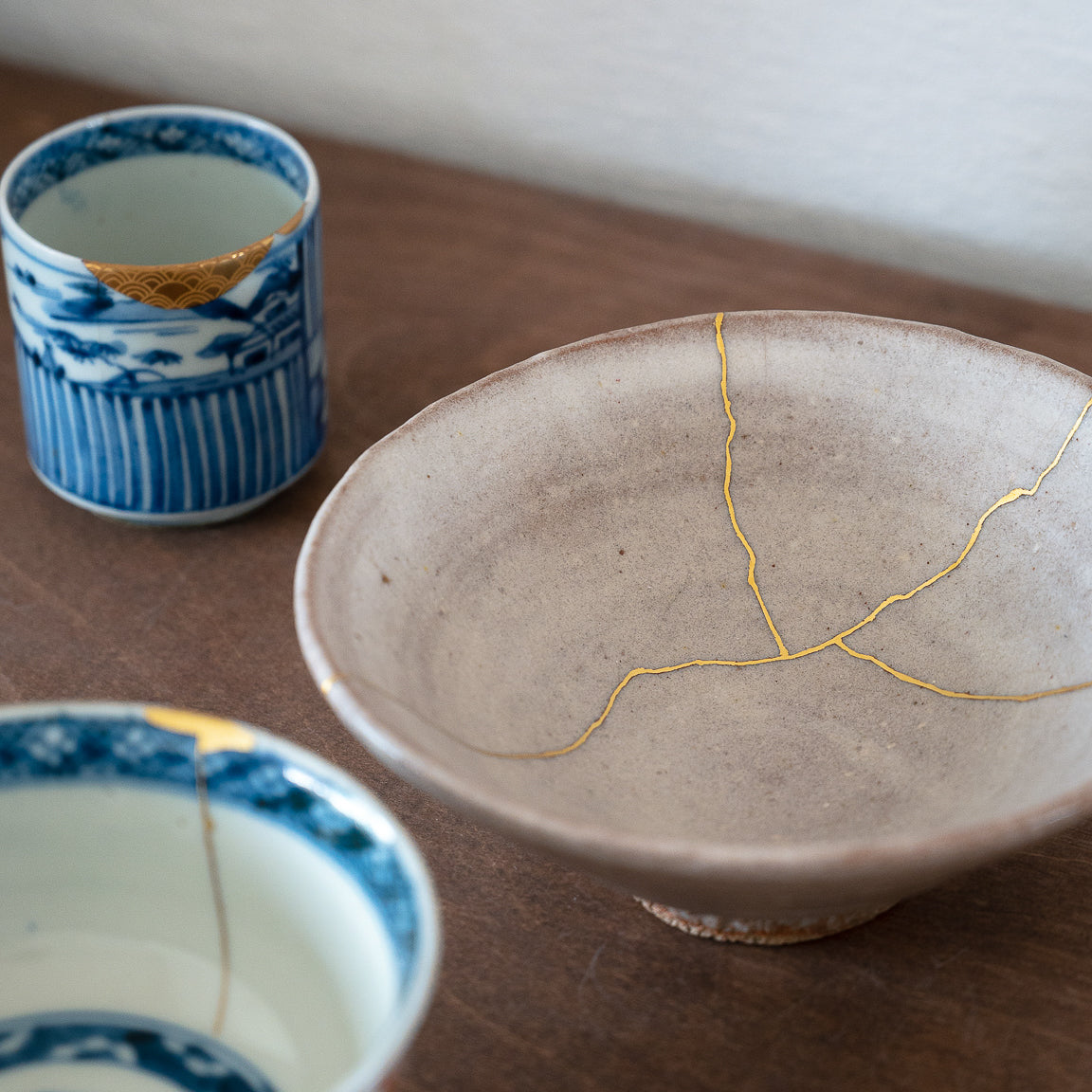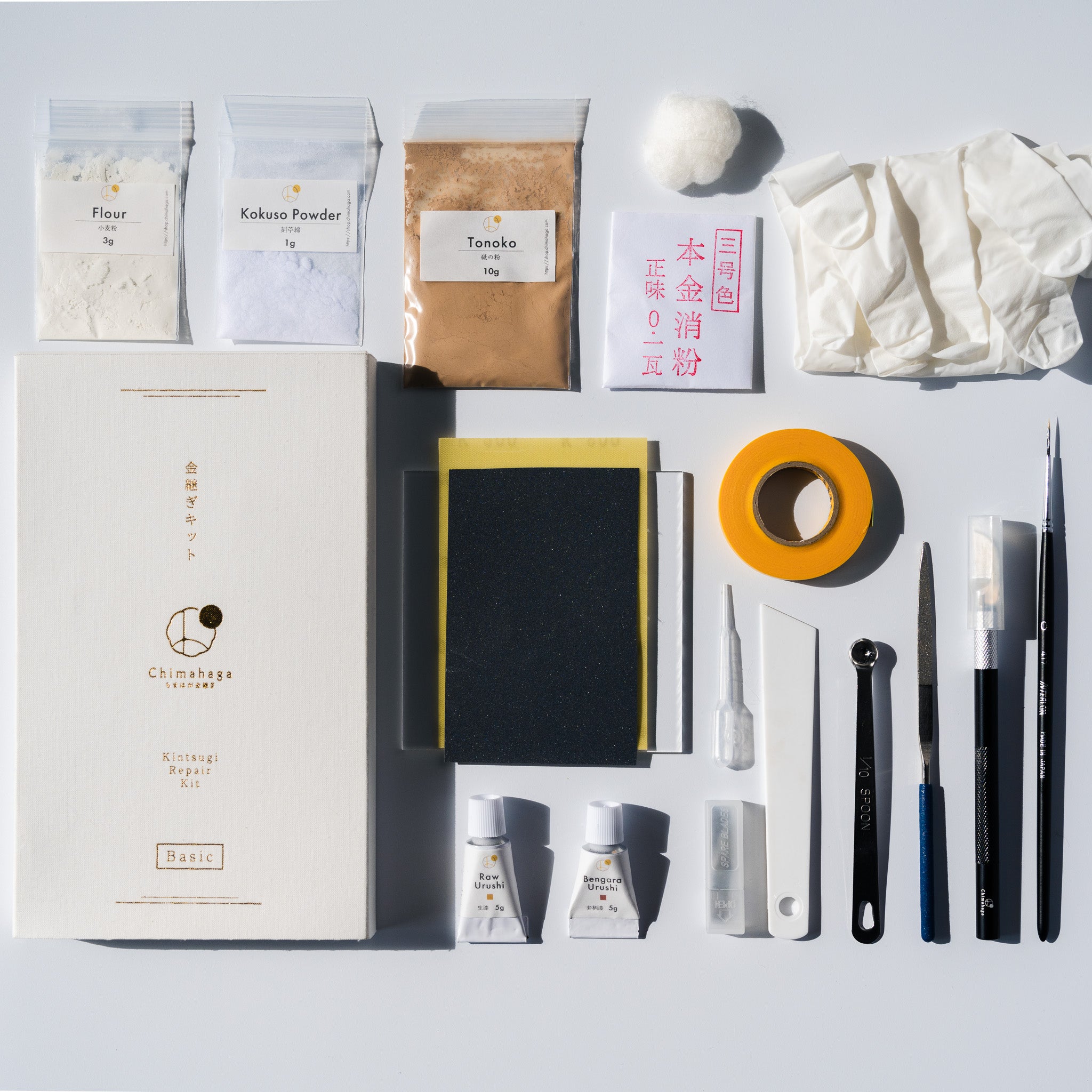こんにちは。ちまはがです。
今回は金継ぎでのありがちな失敗と、その対策法について説明したいと思います。
金継ぎは簡単な技法ではありません。
一連の作業の中には初心者の方がつまづきやすいポイントも多く存在します。
この記事では、そんな典型的な失敗例をいくつか紹介したいと思います。
取り返しのつかない失敗
金継ぎにおける失敗には「取り返しのつく」ものと「取り返しのつかない」ものがあります。
まず、「取り返しのつかない」失敗例を紹介します。
とはいえ、どれも事前の対策を行えば予防できるものなので、作業前に確認しておくようにしましょう。
1. 接着時にズレる
金継ぎで取り返しのつかない失敗のうちの一つです。
接着時のズレの原因はいくつかあります。
一つは、接着時にすでにズレてしまっているケース。
これは接着する時に十分に密着・圧着できていないと発生します。
破片が多いとよりズレやすくなってしまいますが、破片を一つ接着するたびにしっかりマスキングテープで固定しながら進めましょう。
もう一つは接着後に徐々にズレてしまうケース。
これは大きな器などに起こりやすいですが、重力を受けて少しずつ断面がズレてしまうことが原因です。
こちらも対策としては、しっかりマスキングテープで固定すること。
また、平皿など平らな器は縦向きにするなど、重力を受けてもズレにくい向きで保管することも有効です。
2. 器の表面が漆で汚れてしまう
釉薬の薄い器や白い器などの表面に漆が付着すると、汚れが残ってしまう可能性があります。
釉薬のしっかりした器であればエタノールで拭き取ったりカッターで削ったりすれば汚れが綺麗に取れることが多いですが、前述したような器は事前に汚れ対策をしておかないと取り返しがつかないケースがほとんどです。
具体的な対策としては、継ぎ目の周囲にマスキングテープを貼りながら作業することが有効です。
特に、麦漆で接着する工程では、作業中に麦漆が手についてしまい、その手で器のあちこちを触ってしまうことで、マスキングした部分以外にも麦漆が付着し、汚れとなってしまうケースがよく見られる失敗です。
余力があれば、継ぎ目の周囲以外もテープで保護しておくと安心して作業することができます。
3. 継ぎ目の周囲にシミができてしまう
これも漆汚れの一種です。
ただし、先ほどご紹介した汚れは器の表面に漆が付着することが原因でしたが、継ぎ目の周囲にできるシミは器の内側に漆が染みることが原因となって起こります。
白い器によく見られますが、特に粉引の器や柔らかい白土の器でよく起こります。
内側に漆が染みることが原因なので、表面の釉薬がしっかりしているかどうかは関係ありません。
一度できたシミは取り除くことができないので、事前の対策が重要になります。
具体的には、事前に膠や卵白を素地に染み込ませておく「防染」を行ったり、でんぷんを使った「目止め」を行うことで漆の染み込みを弱めることができます。
具体的な工程についてはチュートリアルをご確認ください。
取り返しのつく失敗
次に、「取り返しのつく」失敗例を紹介します。
取り返しがつくので失敗というほどでもありませんが、作業が増えたり手戻りが発生する場合もあるので、作業前に確認しておくとよいでしょう。
1. 真綿でうまく金粉を蒔けない
これは主には3つの原因が考えられます。
なお、金粉を蒔き直す場合は、継ぎ目をエタノールで拭き取って、もう一度弁柄漆を塗るとことから始めましょう。
①弁柄漆を十分に薄く濡れていない
かすれる直前まで薄く塗らないと、金粉を蒔いても漆の中に金粉が沈んでいってしまいます。
②真綿で弁柄漆を擦ってしまっている
綿の使い方で重要なことは、綿自体を弁柄漆に当てないことです。
具体的には、綿を強く押し当てたり、毛羽立ちのない平らな面を作らずに金粉を蒔いたりしないように注意する必要があります。
③真綿の金粉が少ない
真綿で蒔くときは、綿についた金粉だけが弁柄漆に触れるようにするのが理想的です。
そのためには、真綿にたっぷりと金粉を含ませることが非常に重要です。
綿だけではどうしても難しいという場合は、あしらい毛棒を使うことでより安全に金粉を蒔くことができます。
2. 麦漆が固まらない
麦漆が固まらない原因は大きく4つ考えられます。
なお、接着をやり直す場合は、破片を全て外して、断面についた麦漆をエタノールでしっかり拭き取り、麦漆を塗るところから始めましょう。
部分的に麦漆が固まっている部分はカッターで取り除きましょう。
①保管中の温度が低い
漆が固まるのに湿度が必要ということは何度もお伝えしているので理解されている方が多いかと思いますが、温度も重要な要素です。
作業後、濡れタオルを入れた段ボールで器を保管していても、一晩待っているうちに夜間冷え込んでしまい、漆の硬化が十分に進まないというケースがあります。
漆は寒いと固まらないので、湿度だけでなく、温度も20度以上を保てるように注意しましょう。
特に作業後12時間の保管環境は漆の効果に大きな影響を与えるため、可能であれば午前中に作業するなど、気温が下がりにくくなるよう工夫するとよいでしょう。
②器に塩分や油分が付着していた
漆は塩分や油分が混ざると乾きが極端に悪くなります。
器に汚れが残っている場合は、修理前に一度洗剤やエタノールなどで洗い、しっかり乾かしてから修理を開始するようにしましょう。
③マスキングテープの貼りすぎ
麦漆が硬化するには空気と触れ合う必要があります。
そのため、固定用のテープで継ぎ目が塞がれていると麦漆が固まらなくなる場合があります。
固定する時は間隔を開けながらテープを貼るようにしましょう。
④麦漆の塗りが厚かった
麦漆を厚く塗って接着すると、余分な麦漆が継ぎ目からはみ出し、内側の麦漆が空気と触れにくくなってしまいます。
これにより、麦漆の表面だけが硬化し、内側は柔らかいままになるケースがあります。
麦漆を塗る時は薄く塗るようにするか、接着後にはみ出した麦漆を竹ベラなどで取り除くとよいでしょう。
3. 錆漆/こくそ漆がうまく固まらない
錆漆やこくそ漆が固まらない原因は大きく4つ考えられます。
なお、作業をやり直す場合は、継ぎ目に残った錆漆やこくそ漆をエタノールでしっかり拭き取ってから、もう一度塗り直すようにしましょう。
部分的に錆漆やこくそ漆が固まっている部分はカッターで取り除きましょう。
①保管中の温度が低い
漆の硬化においては、湿度だけでなく「温度」も重要な要素です。
作業後、濡れタオルを入れた段ボールで器を保管していても、一晩待っているうちに夜間冷え込んでしまい、漆の硬化が十分に進まないというケースがあります。
漆は寒いと固まらないので、湿度だけでなく、温度も20度以上を保てるように注意しましょう。
特に作業後12時間の保管環境は漆の効果に大きな影響を与えるため、可能であれば午前中に作業するなど、気温が下がりにくくなるよう工夫するとよいでしょう。
②器に塩分や油分が付着していた
漆は塩分や油分が混ざると乾きが極端に悪くなります。
器に汚れが残っている場合は、修理前に一度洗剤やエタノールなどで洗い、しっかり乾かしてから修理を開始するようにしましょう。
③乾き始めた錆漆・こくそ漆を使った
錆漆やこくそ漆など、砥の粉を混ぜたペーストは水分が蒸発しやすく、すぐにパサついてしまいます。
そのような状態のペーストは馴染みが悪く、固まった後で剥がれやすくなってしまいます。
乾いてしまった時は、無理に使おうとせず、もう一度作り直すようにしましょう。
④分厚く塗ってしまっている
錆漆やこくそ漆を分厚く塗ってしまうと、ペーストの内側が空気と触れにくくなってしまいます。
これにより、表面だけが硬化し、内側は柔らかいままになるケースがあります。
こくそ漆は2~3mm以下、錆漆であれば1mm以下の厚みになるように調整しましょう。
4. 黒呂色漆/弁柄漆が固まらない
黒呂色漆や弁柄漆が固まらない原因は大きく3つ考えられます。
なお、作業をやり直す場合は、継ぎ目に残った黒呂色漆や弁柄漆をエタノールでしっかり拭き取ってから、もう一度塗り直すようにしましょう。
①保管中の温度が低い
漆の硬化においては、湿度だけでなく「温度」も重要な要素です。
作業後、濡れタオルを入れた段ボールで器を保管していても、一晩待っているうちに夜間冷え込んでしまい、漆の硬化が十分に進まないというケースがあります。
漆は寒いと固まらないので、湿度だけでなく、温度も20度以上を保てるように注意しましょう。
特に作業後12時間の保管環境は漆の効果に大きな影響を与えるため、可能であれば午前中に作業するなど、気温が下がりにくくなるよう工夫するとよいでしょう。
②筆やアクリル板に油分が残っていた
漆は油分が混ざると湿度を与えても固まらなくなります。
そのため、筆やアクリル板に油分が残っていることに気づかず作業をしてしまうと、塗った漆も固まらなくなります。
作業前にはしっかりエタノールで油分を拭き取るようにしましょう。
③分厚く塗ってしまっている
黒呂色漆や弁柄漆を分厚く塗ってしまうと、表面だけが硬化し、内側は柔らかいままになるケースがあります。
継ぎ目の溝を埋めるために厚塗りする必要があることもありますが、1mm以下の厚みになるように調整しましょう。
5. 金粉を蒔いても赤くなってしまう
これは弁柄漆の塗りが厚かったために、金粉が沈み込んでしまっていることが原因です。
基本的には金粉を追加で蒔いてあげれば途中で沈み込みが止まりますが、ゆっくり沈み込んでいくケースもあるので、最低でも30分は様子を見たほうがよいでしょう。
6. 黒呂色漆/弁柄漆にシワができてしまった
下塗りや中塗りで発生するシワは「縮み」と呼ばれますが、これは主には2つの原因が考えられます。
なお、縮みができてしまった場合は、器に傷がつかない研磨剤などで削り取ったり、カッターで削り取ってもう一度塗り直すようにしましょう。
①保管中の湿度が高すぎる
漆の硬化には湿度が必要ですが、黒呂色漆や弁柄漆は湿度が高すぎてもうまくかたまりません。
具体的には80%を超えると縮みができやすくなります。
可能であれば、加湿を少し弱めたり、加湿源から少し離して保管するようにして、60~70%前後の湿度を保てると縮みが起こりにくくなります。
②塗りが厚い
黒呂色漆や弁柄漆の塗りが厚い場合、湿度が適切に保たれていても縮みが起こりやすくなります。
特に欠けの修理など、面積の広い箇所などは通常よりも縮みやすくなるため、塗りを薄めるか、湿度を弱めるなどの工夫が必要です。
とはいえ、この辺りは初心者の方にはコントロールが難しいポイントになりますし、リカバリーもそんなに手間がかからないので、縮みは起こるものと思って作業をして、縮みができたらその都度削って対応するのがよいかと思います。
最後に
ここまで紹介したものは、よくある失敗例で、これら以外にもさまざまなケースが存在します。
器の種類や破損の状況、修理の進め具体によって最善の対処法が変わってきたりもするので、今回の記事に当てはまらないケースもあります。
もし進め方に迷った場合は金継ぎフォーラムからご相談いただければある程度はお答えできるかと思いますので、お困りの方はそちらからお問い合わせください。(すぐにお返事できないことが多いですが…)


